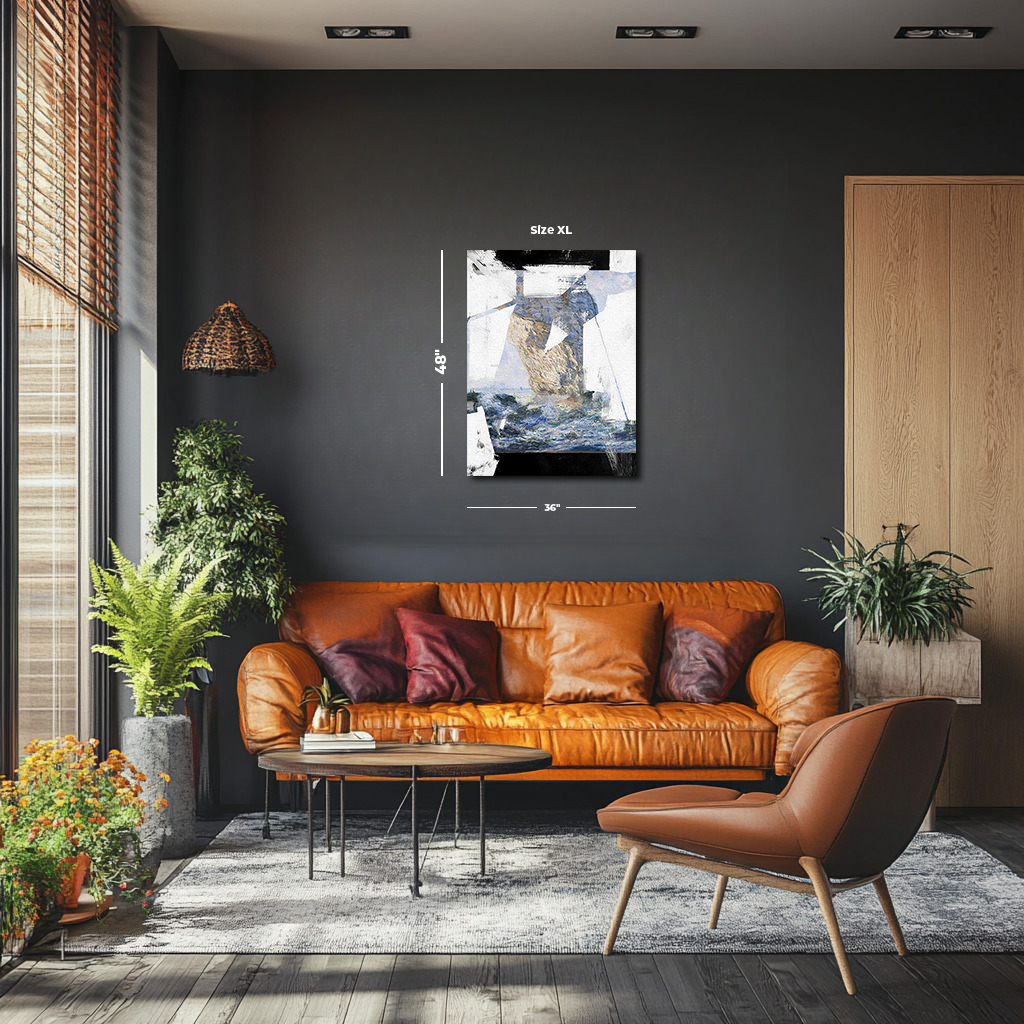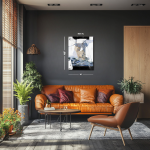The Portal of Light: Monet’s Manneporte Reimagined Through Abstract Expression
"The Portal of Light" reimagines Claude Monet’s The Manneporte (Étretat) as a fragmented, abstract composition blending Impressionist beauty with expressionist boldness. The natural arch is framed by stark white planes and dark geometric shapes, emphasizing the interplay between permanence and impermanence. The luminous blues and greens of the ocean contrast with the stark black and white elements, creating a visual tension that reflects the duality of nature’s timelessness and human perception. This reinterpretation expands Monet’s original vision, transforming the iconic scene into a meditation on light, memory, and the transformative power of art.
Please see Below for Details…
Hotline Order:
Mon - Fri: 07AM - 06PM
404-872-4663
Claude Monet’s The Manneporte (Étretat) , painted in 1883, is an iconic representation of the artist’s fascination with the rugged beauty of the Normandy coast. This natural arch, carved into the chalk cliffs of Étretat, captivated Monet for its monumental form and its ability to interact dynamically with light, weather, and the sea. Currently housed in the Metropolitan Museum of Art, the painting demonstrates Monet’s masterful ability to transform geological forms into vibrant studies of color, light, and movement. In this reinterpretation, "The Portal of Light," the timeless structure of the Manneporte is expanded into an abstract narrative, blending Monet’s Impressionist roots with the bold, fragmented aesthetics of expressionism and conceptual collage.
Monet’s original painting depicts the Manneporte bathed in sunlight, with the crashing waves of the Atlantic Ocean lending motion and energy to the composition. The arch rises like a natural cathedral, its chalky surface catching subtle hues of gold, cream, and violet as the sunlight filters through the ever-changing clouds. The surrounding water, rendered in shimmering blues and greens, reflects the sky and provides a dynamic counterpoint to the solidity of the cliffs. Monet’s loose, gestural brushstrokes bring a sense of immediacy to the scene, inviting viewers to feel the salt air and hear the crashing surf.
In "The Portal of Light," this iconic scene is fragmented and reconstructed, incorporating stark white planes and dark geometric shapes that frame the Manneporte. These abstract elements suggest both a window and a barrier, inviting the viewer to contemplate the interplay between nature’s timelessness and the fleeting human gaze. The arch itself, while still recognizable, takes on a dreamlike quality, appearing almost as a memory or a vision suspended in time. The fragmented composition emphasizes the contrast between permanence and impermanence, stability and flux.
The color palette in this reinterpretation builds upon Monet’s original tones while introducing a starker, more dramatic contrast. The luminous blues and greens of the ocean remain central, symbolizing depth, vitality, and transformation. The chalky whites and golds of the cliffs are accented by stark black and white elements, which evoke a sense of abstraction and modernity. These colors work together to create a visual tension that reflects the duality of the scene: the timeless beauty of the Manneporte and the transient forces of light and weather that shape it.
As an artist, this reinterpretation was inspired by Monet’s ability to render the eternal in the ephemeral. The decision to fragment and abstract the composition was a deliberate choice to explore the ways in which memory, perception, and time interact with natural landscapes. The Manneporte, often likened to a portal or gateway, becomes a symbol of transition and transformation in this work. The abstract overlays emphasize the subjective nature of human experience, suggesting that each viewer’s encounter with the Manneporte is as unique and fleeting as the light that plays across its surface.
The stark geometric elements in the composition add layers of complexity and invite multiple interpretations. They can be seen as symbolic of human constructs—frames through which we view and interpret nature—or as barriers that challenge us to look beyond the surface and engage with deeper meanings. The interplay of abstraction and realism reflects the tension between the physical and the metaphysical, the seen and the unseen.
Monet’s The Manneporte (Étretat) is celebrated for its ability to capture the monumental beauty of one of France’s most iconic natural landmarks. "The Portal of Light" honors that legacy while reimagining the scene as a multidimensional exploration of memory, perception, and the transformative power of nature. By blending Monet’s Impressionist sensibilities with abstract and expressionist techniques, this reinterpretation invites viewers to step through the portal and into a realm where time, light, and space converge.
This reimagined composition serves as a meditation on the enduring beauty of nature and its ability to inspire awe, reflection, and transformation. It challenges viewers to consider the ways in which art can expand our understanding of the world and our place within it, offering a timeless connection to both the past and the present.
Add your review
Your email address will not be published. Required fields are marked *
Please login to write review!
Looks like there are no reviews yet.








